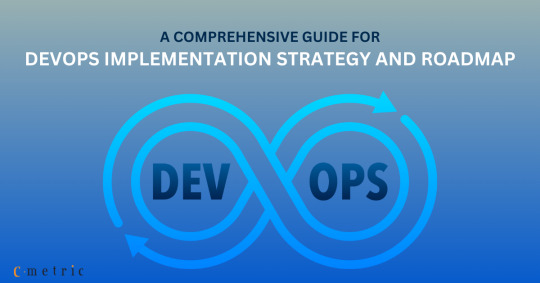#DevOpsStrategy
Explore tagged Tumblr posts
Text

Unlock Agility and Efficiency with Seamless DevOps Integration
Transform your business with Stigasoft’s comprehensive DevOps Consulting Services and Solutions. Our expertise fosters collaboration and synergy between development and operations teams, resulting in:
Faster Software Delivery: Accelerate your release cycles to stay competitive.
Enhanced Collaboration: Break down silos and improve communication for better outcomes.
Increased Efficiency: Streamline processes to reduce waste and optimize resources.
Organizational Success: Drive growth and innovation through integrated practices.
Experience the power of DevOps to fuel your business growth and achieve operational excellence with our DevOps Services and Solutions.
0 notes
Text
A Comprehensive Guide for DevOps Implementation Strategy and Roadmap

This comprehensive guide delves into the transformative potential of DevOps, providing a strategic roadmap for integrating development and operations to accelerate software delivery. It highlights how DevOps promotes collaboration, automates processes, and employs CI/CD to enhance efficiency and security. Gain actionable insights and best practices to innovate quickly and boost customer satisfaction. Ideal for those embarking on or refining their DevOps journey, this guide is your first step towards realizing its full benefits.
0 notes
Text

Are you looking to enhance your software development and operations processes through DevOps practices? Look no further than Goognu, a trusted platform connecting businesses with top DevOps consulting companies. Our curated selection of industry-leading experts can help your organization streamline workflows, improve collaboration, and achieve continuous integration and delivery.
Visit here for more information: https://goognu.com/services/devops-consulting-services
0 notes
Video
youtube
A Step-by-Step Guide to Develop a Successful DevOps Strategy - Implementing a DevOps strategy can significantly enhance efficiency and productivity while minimizing costs related to manual processes. In this regard, our DevOps advocate has outlined a step-by-step guide to successfully implementing and managing a DevOps strategy that can work wonders for organizations. By following a well-crafted DevOps implementation plan, organizations can establish a practical collaboration framework between IT operations, development teams, and business units, leading to improved outcomes.
1 note
·
View note
Text
Organizations need to become more DevOps-driven to have coordinated and high-performing development teams. This article outlines a detailed DevOps strategy to reduce implementation failure and fast-track your company’s software delivery pipelines.
0 notes
Photo

@devopsdotcom : As organizations consider implementing DevOps, they need to think about what problems it solves and what role it will play in their organization. https://t.co/HDky8gRpdq #devopsadoption #devopsbenefits #devopsstrategies https://t.co/BRRUFdSsdr
0 notes
Text
Goognu Provider DevOps Consulting Services
Goognu provider DevOps consulting services, specializing in empowering organizations to optimize their software delivery process. Our team of experienced DevOps consultants is committed to helping businesses embrace DevOps principles and practices, enabling them to achieve greater agility, efficiency, and reliability in their software development lifecycle.
0 notes
Text

DevOps helps businesses efficiently run operations through an automated, streamlined process. Call us now to add value to your business with state-of-the-art DevOps solutions.
https://wa.me/919535555225
#DevOps#Agile#ContinuousIntegration#ContinuousDelivery#DevOpsCulture#DevOpsEngineer#DevOpsTools#Automation#DevOpsConsulting#DevOpsServices#DevOpsTransformation#DevOpsSecurity#DevOpsBestPractices#DevOpsStrategy#DevOpsCommunity#DevOpsImplementation#DevOpsDeployment#DevOpsAutomation#DevOpsMaturity#DevOpsSolutions#june#softwarecompany#softwaredevelopment#business
0 notes